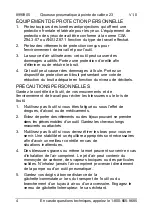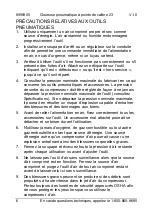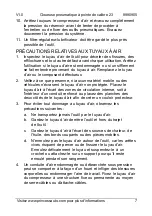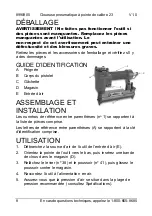
8990905
23 Gauge Pin Air Nailer
V1.0
6
For technical questions call 1-800-665-8685
8.
Do not leave the air tool unattended with its compressed air
supply on. Turn off the compressed air supply and bleed the air
tool of any remaining compressed air before leaving the air
tool unattended.
9.
Serious injury may occur from loose debris being propelled at high
speeds from the compressed air stream. Always wear OSHA
approved safety glasses to protect the eyes during operation of
the air compressor.
10. Always turn off the air compressor and drain tank pressure
completely before attempting maintenance or attaching air
tools. Release pressure slowly from the system.
11. A filter-regulator-lubricator should be kept as close to the tool
as possible.
AIR HOSE PRECAUTIONS
1.
Inspect the tool's air hose for cracks, fraying or other faults
before each use. Discontinue use if the air hose is damaged or
hissing is heard from the air hose or couplers. Replace the
defective air hose.
2.
Do not allow people, mobile equipment or vehicles to pass over
the unprotected air hose. Position the air hose away from high
traffic areas, in a reinforced conduit or place planks on both
sides of the air hose to create a protective trench.
3.
Prevent damage to the air hose by observing the following:
a.
Never carry the tool by the air hose.
b.
Keep the air hose behind the tool and out of the tool's
work path.
c.
Keep the air hose away from heat, oil, sharp edges or
moving parts.
d.
Do not wrap the air hose around the tool as sharp edges
may pierce or crack the air hose. Gently coil the hose and
either hang on a hook or fasten with a device to keep hose
together when storing.
4.
A damaged or disconnected air hose under pressure may whip
around and inflict personal injury or damage the work area.
Secure the compressor's air hose to a fixed or permanent
structure with clamps or cable ties.







































